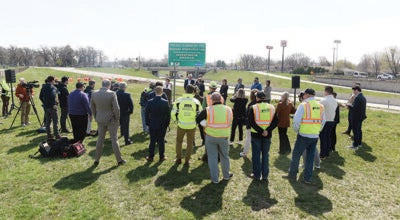Where is it?
Published 10:30 am Friday, April 16, 2010
What is the highest elevation in Albert Lea?
A copy of the city directory says the city is 1,256 feet above sea level, but the location and elevation of the highest is undetermined. Because the water in the city generally flows south and southeast, somewhere on the north side is the highest. The northernmost point within the city limits is the Good Samaritan Society of Albert Lea along Freeborn County Road 14.
What is the longest street in Albert Lea?
Albert Lea City Engineer Steve Jahnke says it’s Main Street. The actual mileage for this street (which is also designated as Freeborn County Road 46) within city limits is 5.3 miles. Jahnke added that Bridge Avenue appears to be the city’s second longest street. It’s length from the Clark Street intersection to the Bancroft Corner, all within city limits, is 3.7 miles. Proof that the north end of this street is part of the city can be seen on a signpost at the Hoeger Lane intersection, which also has the Bridge Avenue designation.
What is the oldest street in Albert Lea?
Linda Evenson, librarian at the Freeborn County Historical Museum, says it’s Clark Street. This street is named for Julius Clark, who was the city’s first store owner and resident of Albert Lea from March 1856 to about 1859. His store became a center of area commerce 15 decades ago and it is logical that the street evolved in front of his place of business.
Where was the first building in Glenville?
Linda Evenson says the first recorded building in Shell Rock City, now Glenville, was a schoolhouse in 1857, reportedly the first school in Freeborn County.
Who is Morin Lake named for?
An early Albert Lea resident named William Morin (1827-1887). He was an Irish immigrant and Albert Lea pioneer and the first of four generations of the Morin family to have the first name of William. (The other three generations in this family had different middle names.) He is considered to be one of the founders of Alden. Morin purchased land in the area after the railroad arrived in 1869 and was the largest landowner in the county during his lifetime. He is also given credit for being one of the community’s pioneers who converted a slough area into the present Morin Lake during 1871.
Where in the world was the town of Norman?
About a mile south of Emmons into Iowa. A few houses are there today. This community is located in Norway Township of Winnebago County. In 1879 the Minneapolis and St. Louis Railroad built a branch line southwest of Albert Lea. The depot for this area was located at Norman. However, just to the north and barely into Minnesota was a locality known as State Line, which evolved into the present Emmons in 1899. This new town was growing and Norman wasn’t. As a result, they wanted a railroad depot. What evolved was a feud between the two localities over the depot’s location. Emmons won in a way when the railroad was forced to move its depot a mile to the north in 1904. Then again, Emmons lost out because the depot was still barely within Iowa. In time, the depot was designated for both Emmons, Iowa, and for Emmons, Minn. In 1963 the former depot building was sold and moved about two miles southeast of Emmons to a farm in Silver Lake Township, Worth County, Iowa, where it is today.
How many miles of interstate highway are there in Freeborn County?
Just over 54 miles. This ranks second place within the state outside the Twin Cities area. First place honors go to Stearns County, which has at least 58 miles of Interstate 94 from West Union to Clearwater.
What is the largest building (by square footage) in Albert Lea?
Larson Manufacturing Distribution Center, 1501 Betha Larson Lane. According to Doug Johnson, Albert Lea’s building inspector, this building has a “footprint” or base of 281,000 square feet. The second largest building is Albert Lea High School, 2000 Tiger Lane, with 194,000 square feet. The city’s tallest building is Shady Oaks Apartments, 800 S. Fourth St., with eight full floors.
Is Ellendale named for an Ellen?
Yes. She was Mrs. C.J. Ives, the wife of the president of the Chicago, Rock Island & Pacific Railroad. Ellen Ives died a few years before the town of Ellendale was named in 1901, according to a reference book on Minnesota geographical names.
Whatever happened to U.S. Highway 16?
U.S. Highway 16 originally connected Detroit with Worland, Wyo., with a gap for Lake Michigan handled by a car ferry. Designated in 1926, it went through the southern tier of counties in Minnesota on its way, taking Main Street of Albert Lea and Oakland Avenue in Austin. In 1962, the eastern terminus became Milwaukee because Interstate 96 was completed in Michigan. The old route was handed over to local entities.
By 1965, suburb Waukesha, Wis., became the eastern terminus, and east entrance to Yellowstone National Park became the western terminus. In 1978, La Crosse, Wis., became the eastern terminus, as I-94 and I-90 was built Wisconsin. The route remains Wisconsin Highway 16, connecting La Crosse to Waukesha.
With the construction of Interstate 90 finished in 1978, Minnesota decommissioned U.S. 16 in 1979. The east-west roadway across Freeborn County is now designated as County Road 46. Many counties in Minnesota designate the same route across the state with County 46 or County 16, but starting near Dexter, that same roadway becomes Minnesota Highway 16, taking motorists through the bluff country to La Crescent.
South Dakota that same year also decommissioned U.S. 16 from the Minnesota border to Sioux Falls, then decommissioned the route to Rapid City in 1980, replacing it with state highways or the freeway itself. That left U.S. 16 as it is today, connecting Rapid City with Yellowstone.





